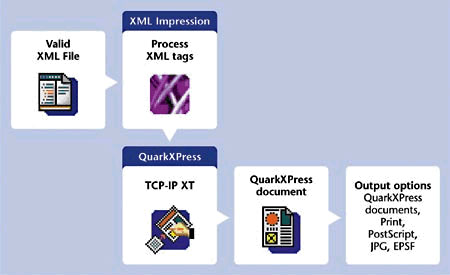XMLImpression Suite
Automate document creation
XML Impression Suite is the ultimate print-publishing solution to automate QuarkXPress using XML standards. It's not just an XML import filter, XML Impression can automate document creation and initiate the output process. It makes XML easier to (re)use and combines the power of QuarkXPress with automation.
The content of an XML file is used to automatically create, save, and output QuarkXPress documents. The XML file defines the needed template and where to store the result document(s). It can dynamically lay out content, replace existing content, and create new pages and page items. To achieve this, the XML Impression module drives the proven technology of the TCP-IP XT engine, an QuarkXPress XTension. TCP-IP XT is an advanced platform-independent, location-independent, and authoring-independent scripting command set.
To ensure correct processing, the XML content must meet certain criteria. The XML file needs to be well formed and conform to the Techno Design DTD (valid XML). XML content can be created using various XML authoring tools and databases (for instance, FileMaker Pro 6, Microsoft SQL, and Oracle).
The XML Impression module is designed to make use of prepared templates, style sheets, and page items. It brings in and adjusts predefined items. XML Impression involves the following elements: a valid XML file (Techno Design DTD) and one or multiple prepared QuarkXPress files or templates.
At this stage, XML Impression itself is not an XTension. It is a stand-alone application that processes XML data and sends commands to QuarkXPress. The TCP-IP XT needs to be active in QuarkXPress. As XML Impression can check watched or hot folders the application can easily be implemented as part of a fully automated, print-publishing environment.
Features:
- use XML data to automate document creation in QuarkXPress;
- allows easy publishing of XML content in print and PDF;
- dynamically create, save, and output QuarkXPress document;
- batch process XML files using watched folders;
- replace existing content;
- create new pages and page items;
- suits any template-driven publication;
- build final or semi-manufactured documents; and
- process any XML file conforming to the Techno Design DTD.





